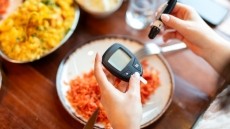Omega-3: ALA intakes enough for EPA/DPA levels for non-fish eaters?
Despite having significantly lower intakes of EPA and DHA (associated with fish consumption), blood levels of EPA and DHA in vegans and vegetarians were approximately the same as regular fish eaters, according to findings published in the American Journal of Clinical Nutrition.
The results indicate that when people do not consume adequate levels of EPA and DHA, like vegans and non-fish-eating vegetarians, their bodies respond by increasing the conversion levels of ALA to EPA.
“The implications of this study are that, if conversion of plant-based sources of n-3 PUFAs were found to occur in intervention studies, and were sufficient to maintain health, it could have significant consequences for public health recommendations and for preservation of the wild fish supply,” wrote the researchers, led by Ailsa Welch from the University of East Anglia in England.
Background
Alpha-linolenic acid (ALA) omega-3 is an essential fatty acid that the body cannot make, and therefore must be consumed in the diet. Good sources of ALA include: flaxseed, soybeans, walnuts, and olive oil. The U.S Institute of Medicine recommends an ALA intake of 1.6 grams per day for men and 1.1 grams per day for women.
The health benefits associated with alpha-linolenic acid (ALA) consumption include cardiovascular effects, neuro-protection, a counter to the inflammation response, and benefits against autoimmune disease.
However, the longer-chain eicosapentaenoic acid (EPA) and docosahexaenoic acid (DHA) have received more study from scientists and more attention from the consumers.
Much attention has been paid to the conversion of ALA to the longer chain EPA, with many stating that this conversion is very small. According to an article in Nutrition Reviews (Vol. 66, pp. 326-332), between eight and 20 per cent of ALA is converted to EPA in humans, and between 0.5 and nine percent of ALA is converted to DHA.
In addition, the gender plays an important role with women of reproductive age reportedly converting ALA to EPA at a 2.5-fold greater rate than healthy men.
This conversion obviously contributes to the body's pool of EPA and DHA, which play a key role in, amongst other things, maintaining cardiovascular health.
“Because fish and fish oils are the most concentrated sources of EPA and DHA, individuals who do not eat fish or fish oil (eg. vegans and non-fish-eating vegetarians and meat eaters) could be at risk of low or inadequate n-3 PUFA status,” wrote the researchers.
“In addition, because the supply of wild fish is under threat and supplies are compromised, if the maintenance of adequate n-3 PUFA status via conversion of plant-derived ALA was possible this could reduce the requirements for fish and help preserve the fish supply,” they added.
Study details
Dr Welch and her co-workers analyzed intakes of omega-3 polyunsaturated fatty acids (PUFAs), and correlated with blood levels of ALA, EPA, and DHA in fish-eaters and non-fish-eating meat-eaters, vegetarians, or vegans. The researchers included 14,422 men and women aged between 39 and 78 participating in the EPIC-Norfolk cohort. Blood levels of fatty acids were measured in 4,902 people.
Results showed that omega-3 intakes were between 57 and 80 percent lower in the non-fish-eaters, compared with fish-eaters. However, for plasma levels of DHA and EPA between the groups the differences were much smaller. Indeed, the average EPA level in fish eaters was 64.7 micromoles per liter, compared with 57.1, 55.1, and 50 micromoles per liter for non-fish-eating meat-eaters, vegetarians, or vegans. Furthermore, the average DHA level in fish eaters was 271 micromoles per liter, compared with 241.3, 223.5, and 286.4 micromoles per liter for non-fish-eating meat-eaters, vegetarians, or vegans.
“One explanation for this observation may be due to increased conversion, and our data suggest that the precursor-product ration from plant-derived ALA to circulating long chain n-3 PUFAs was significantly greater in non-fish eaters than in those who ate fish,” wrote the researchers.
“Although there have been many small, careful metabolic studies determining the extent of conversion, we believe this to be the first large population study to investigate intakes, status, and the precursor-product ratio by using statistical models as, surrogate, estimates of conversion of ALA to long chain n-2 PUFAs in different dietary habits.”
Biochemistry
The conversion of ALA to EPA involves the delta6-desaturase enzyme to form stearidonic acid (SDA). An enzyme (malonyl co-enzyme A) then elongates the SDA from an 18-carbon chain to a 20-carbon chain, and further desaturation, this time by the delta5-desaturase enzyme, results in the production of EPA.
Welcome
The study was welcomed by Loren Ward, director of research for Glanbia Nutritionals. "This is a very interesting study that enhances our understanding of the conditions needed to convert the essential fatty acid, ALA, to EPA and DHA," said Ward.
"Quantifying dietary intake of ALA, DHA and EPA and measuring plasma levels of ALA, DHA and EPA allowed the researchers to calculate a conversion ratio. While there were very large differences in dietary intake, plasma levels did not show the same degree of variation. The differences in plasma were much smaller than what would be expected and results suggested that the best conversion rates are by individuals that don't consume DHA and EPA.
"This study supports past research showing greater conversion in women versus men and higher conversion in non-fish eaters compared to fish eaters. Future studies are needed to expand our understanding of factors that influence conversion of ALA to DHA and EPA and outline the key physiological roles of ALA," he added.
Source: American Journal of Clinical Nutrition
November 2010, Volume 92, Number 5, Pages 1040-1051, doi:10.3945/ajcn.2010.29457
“Dietary intake and status of n–3 polyunsaturated fatty acids in a population of fish-eating and non-fish-eating meat-eaters, vegetarians, and vegans and the precursor-product ratio of {alpha}-linolenic acid to long-chain n–3 polyunsaturated fatty acids: results from the EPIC-Norfolk cohort1,2,3
Authors: A.A. Welch, S. Shakya-Shrestha, M.A.H. Lentjes, N.J. Wareham, K-T. Khaw















